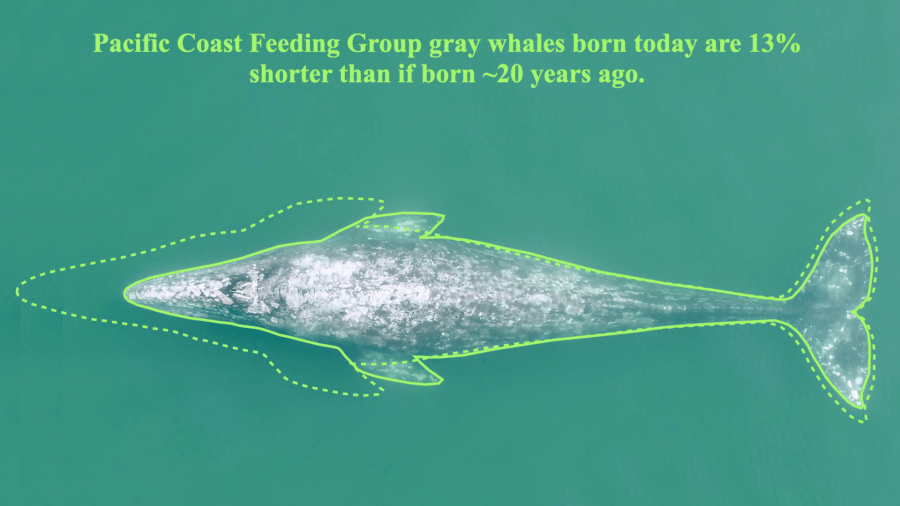Whales in the Pacific Northwest are shrinking. Here’s why researchers are concerned
PORTLAND, Ore. (KOIN) – A new Oregon State University study found that whales in the Pacific Northwest are shrinking — raising “alarm bells” for scientists about their future.
Over the last 20-30 years, gray whales that spend their summers feeding in shallow waters off the coast of the Pacific Northwest have been getting about 13% shorter, according to the study.
“This could be an early warning sign that the abundance of this population is starting to decline, or is not healthy,” said K.C. Bierlich, co-author of the study and an assistant professor at OSU’s Marine Mammal Institute in Newport.
Beaverton police vehicle hit by IED, suspect at large
“Whales are considered ecosystem sentinels, so if the whale population isn’t doing well, that might say a lot about the environment itself,” Bierlich said.
During the study, researchers used drones to take photos of the Pacific Coast Feeding Group, which is a small subset of about 200 whales within the larger Eastern North Pacific population of about 14,500.
The subgroup stays closer to the shore on the Oregon coast and feeds in shallow, warmer waters compared to the Arctic seas where a majority of gray whales spend most of the year. The subgroup is also smaller and in worse body condition than their ENP counterparts.
Menacing suspect arrested after Salem police find brass knuckles, possible fentanyl in truck
Using photos from 2016 to 2022, researchers determined that a full-grown whale born in 2020 is expected to reach 1.65 meters (about 5’5″ tall) in body length as an adult, which is shorter than a gray whale born before 2000.
For whales in the subset that grow to be 38-41 feet long, this means the whales are shrinking by more than 13% of their total length, researchers said.

That would be similar to the average American woman shrinking from 5’4″ tall to 4’8″ tall over the course of 20 years, researchers said.
This could pose “major consequences” for the subgroup’s overall health and reproductive success, according to the scientists.
“In general, size is critical for animals,” said Enrico Pirotta, lead author on the study and a researcher at the University of St. Andrews in Scotland. “It affects their behavior, their physiology, their life history, and it has cascading effects for the animals and for the community they’re a part of.”
Flight diverts after Oregon man is accused of exposing himself, urinating in aisle
“With them being smaller, there are questions of how effectively these PCFG gray whales can store and allocate energy toward growing and maintaining their health. Importantly, are they able to put enough energy toward reproduction and keep the population growing?” Bierlich added.
Researchers are also concerned that the whale’s smaller body size and lower energy may make them less resilient to injuries as some whales have scars from boat strikes and getting tangled in fishing gear.
The state of the food web
While there’s “major concern” among the scientists about the gray whales, the study also pointed to concerns about the state of the food web.
Portland Street Response spots fire, calls 911, put on hold
During the study, researchers also analyzed patterns of ocean upwelling – which sweeps nutrients from deeper regions to shallow regions – and relaxation, which allows nutrients for gray whales to stay in shallow areas.
“Without a balance between upwelling and relaxation, the ecosystem may not be able to produce enough prey to support the large size of these gray whales,” said co-author Leigh Torres, associate professor and director of the GEMM Lab at OSU.
“We haven’t looked specifically at how climate change is affecting these patterns, but in general we know that climate change is affecting the oceanography of the Northeast Pacific through changes in wind patterns and water temperature,” Torres said. “And these factors and others affect the dynamics of upwelling and relaxation in the area.”
Next, the researchers are examining environmental factors driving the shrinking body size.
Copyright 2024 Nexstar Media, Inc. All rights reserved. This material may not be published, broadcast, rewritten, or redistributed.
For the latest news, weather, sports, and streaming video, head to KOIN.com.

